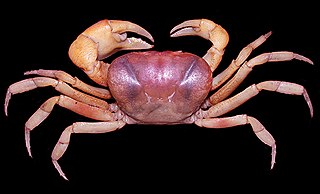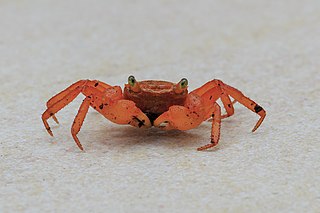
Green papaya salad is a spicy salad made from shredded unripe papaya. It is generally believed to have been created by the Lao people and is considered one of the national dishes of Laos. Green papaya salad is also popular in neighbouring Thailand's Isan region, whose population is mainly composed of ethnic Lao and from where it spread to the rest of Thailand known as som tam. Green papaya salad has also spread to the rest of the continental Southeast Asia, as well as Xishuangbanna (China).

Parathelphusinae is a subfamily of freshwater crabs, which was formerly placed in the family Parathelphusidae; they are mainly found in South and Southeast Asia, but also found elsewhere in Asia and in Australia. The family is now considered as a junior synonym of the family Gecarcinucidae.

The Gecarcinucidae are a family of true freshwater crabs. They are found throughout South Asia, Southeast Asia and New Guinea, with a single genus found in Australia.

Somanniathelphusa is a genus of freshwater crabs found in southeast China, Taiwan, and southeast Asia. It includes the following species:

Geosesarma is genus of small freshwater or terrestrial crabs, typically less than 10 mm (0.4 in) across the carapace. They live and reproduce on land with the larval stages inside the egg. They are found from India, through Southeast Asia, to the Solomon Islands and Hawaii.
Villalobosius is a genus of crabs in the family Pseudothelphusidae, containing a single species, Villalobosius lopezformenti. It lives in the northern part of the state of Oaxaca, Mexico, on the Isthmus of Tehuantepec, and is adapted to a troglobitic lifestyle.

Around 1,300 species of freshwater crabs are distributed throughout the tropics and subtropics, divided among eight families. They show direct development and maternal care of a small number of offspring, in contrast to marine crabs, which release thousands of planktonic larvae. This limits the dispersal abilities of freshwater crabs, so they tend to be endemic to small areas. As a result, a large proportion are threatened with extinction.

Seychellum alluaudi is a species of freshwater crab endemic to the Seychelles, and the only true freshwater crab in that country. It lives in rainforest streams on the archipelago's granitic high islands. Although it may be abundant, little is known about its biology. If its habitat were to decline in quality, S. alluaudi might become endangered, but it is currently listed as Vulnerable on the IUCN Red List.
Indochinamon is a genus of freshwater crabs, typically found in the Indo-China region.

Eosamon is a genus of freshwater crabs in the subfamily Potamiscinae, found in East and South-East Asia.
Sayamia is a genus of freshwater crabs, found in South-East Asia. Three species are included on the list of least concern (lc) arthropods, but S. melanodactylus is endangered.

Mekhongthelphusa is a genus of freshwater crabs in the family Gecarcinucidae, found in South-East Asia.

Esanthelphusa is a genus of freshwater crabs, found in South-East Asia.

Parathelphusa pantherina, commonly known as the "panther crab", is a variety of freshwater crab from Indonesia from the family of the Gecarcinucidae. The scientific name of the species was published for the first time in 1902 by Schenkel. The species is categorized as Endangered by IUCN Red List due to damage to their habitat by mining of nickel from lake shores where they live, which negatively impacts their water quality.

Ghatiana is a genus of freshwater crabs, found among the Western Ghats in India.

Esanthelphusa dugasti is a species of crab that belongs to the family Gecarcinucidae. Esanthelphusa dugasti lives in India, Myanmar, Cambodia, Laos, Vietnam, and Thailand. People in northern Thailand rely on Esanthelphusa dugasti as a source of protein.
Esanthelphusa nimoafi is a species of crab of the family Gecarcinucidae. The crab is native to Laos.
Somanniathelphusa lacuvita is a species of crab that belongs to the family Gecarcinucidae. The species was first found in Cambodia. The crab is found in rice paddies. When undercooked, it can transmit lung flukes to humans.
Somanniathelphusa pax is a species of crab that belongs to the family Gecarcinucidae. The species was first identified in 1995 in Vietnam.











